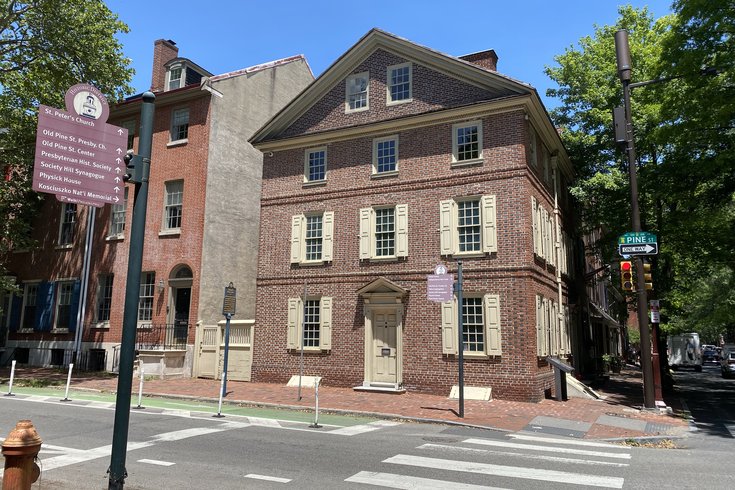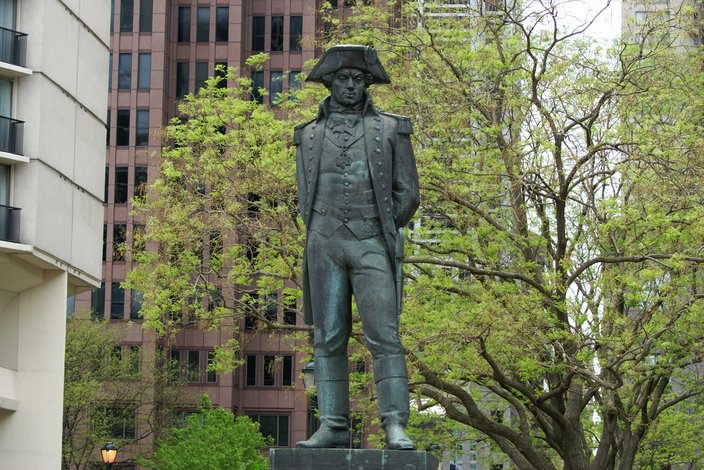
June 26, 2024
 Kristin Hunt/PhillyVoice
Kristin Hunt/PhillyVoice
Thaddeus Kościuszko's former home is located on the corner of Third and Pine streets.
The American Revolution wasn't won without a little help. While the contributions of France are well-known thanks to Benjamin Franklin's extensive diplomacy there (and Daveed Diggs' swaggering turn as the Marquis de Lafayette in "Hamilton"), the work of our Polish allies is less remembered. But one freedom fighter from the country made such an impact that he earned a National Park Service site — the only one dedicated to a European officer who fought in the Revolutionary War.
Philadelphians could easily miss the Thaddeus Kościuszko National Memorial while walking through Old City. At .02 acres, it is the smallest unit in the entire NPS network of parks, memorials, recreation centers and monuments. Kościuszko occupied the brick home in 1797, long after he'd first set foot in colonial America as an aspiring leader with something to prove.
Kościuszko was born in a manor in modern-day Belarus, then part of the Polish-Lithuanian Commonwealth. He received a world-class education there at the royal military academy and abroad in France, where he studied on a royal scholarship. After reading philosophers like John Locke and Thomas Hobbes, he latched onto Enlightenment concepts of democracy and government based on the will of the people.
Kościuszko was now a considerable military asset, trained in engineering and strategy, but he had no experience on the ground. That changed in 1776, when he boarded a ship for Philadelphia. He arrived just weeks after the Declaration of Independence was signed, and fresh off a devastating breakup from his aristocratic fiancee Ludwika Sosnowski.
"Kościuszko really did not fit this young lady's father's idea of who he expected his daughter to marry," explained Andrew McDougall, a public affairs officer for Independence National Historical Park. "He's familiar with the concepts being floated around (America) at that time, that there is no divine right of kings. So he's got that ideological background. There was no real place for him in the dwindling Polish army.
"I think these factors combined to make him say, I'm going to throw my lot in with the American cause."
McDougall said Kościuszko arrived in town "going for the big guns": a spot under George Washington in the Continental Army. But given his lack of battle experience, the brass sent him to the banks of the Delaware River to work on fortifications. Drawing on his engineering education, Col. Kościuszko designed Fort Mercer and barriers that slowed the advancing British army — and caught the attention of Washington. In a Dec. 9, 1776, letter to John Hancock, the general referenced an "engineer of eminence in Philadelphia at this time," recommending him for further work.
Though Washington misidentified that engineer of eminence as French, the letter did result in increasing responsibilities for Kościuszko. In 1777, he was sent north to Saratoga, where he helped the Americans achieve a crucial victory. Working under Gen. Horatio Gates, he assessed the topography for advantages and shaped the military strategy.
"Gates is essentially being pushed southward through the very thick forest of upstate New York," McDougall said. "Gates knows he's going to have to stop and confront the British. So he says to Kościuszko, who's his engineer on the scene, find me a spot to do this.
"So he picks a location where the Hudson River is on the right flank of the army, and you have some hills and mountains on the left flank. And they just kind of funnel the British army right into Gates. There are some brutal, bloody battles that occur. But then we have an American militia come in from the north, and essentially (British) Gen. (John) Burgoyne is trapped."
Burgoyne ultimately surrendered his entire army, over 6,000 troops, on Oct. 17, 1777. This defeat made a massive splash overseas, winning the support of a crucial ally.
"When the king of France heard about the American victory, he said, you know what, this is our chance. The Americans seem to know what they're doing, we're going to jump in here," McDougall said. "This is huge. It changes the American Revolution into a world war."
The Polish Heritage Society of Philadelphia donated this statue of Thaddeus Kościuszko on 18th Street and Benjamin Franklin Parkway in honor of the U.S. bicentennial. It was created by Polish sculptor Marian Konieczny.
Kościuszko also designed the fortifications for West Point before the war ended, and he sailed back to Poland. Emboldened by what he had just seen, Kościuszko attempted to replicate the American Revolution in his homeland. He fought in the Polish-Russian War of 1792, which ended in the Polish king's surrender, and rallied the serfs two years later in an uprising against the Russian empire. This revolution also ultimately failed, landing Kościuszko in the prisons of Catherine the Great.
When he was freed by her son Paul I, Kościuszko returned to Philadelphia. Crowds greeted him at the waterfront, heralding a hero's return. He took up residence in a boardinghouse on Pine Street, where he met with dignitaries like Chief Little Turtle of the Miami people, and Vice President Thomas Jefferson. Kościuszko formed a close friendship with Jefferson, whom he entrusted with his will. Its stipulations undoubtedly made Jefferson, an enslaver, uneasy. Kościuszko wanted his assets to be used to free as many enslaved people as possible, directing Jefferson to purchase the freedom of his own enslaved people "or any others and giving them Liberty in my name."
Kościuszko left America again and spent his last years bouncing around western Europe. When he died in Switzerland in 1817, a decades-long battle over his wills — it turned out there were actually four — ensued. His dream of freeing enslaved people was thwarted in the process; his money was largely gobbled up by a crooked executor who took over Jefferson's duties after the Founding Father's death.
It's easy to read this conclusion, paired with his many frustrated attempts to free Poland, as a disappointing end for a tireless freedom fighter. But Kościuszko's ideals won out in the centuries after his death through the Emancipation Proclamation and, finally, a Polish republic. His memory is also alive in his surrogate city of Philadelphia, home to a monument on 18th Street and Benjamin Franklin Parkway, and his old Pine Street house.
Follow Kristin & PhillyVoice on Twitter: @kristin_hunt
| @thePhillyVoice
Like us on Facebook: PhillyVoice
Have a news tip? Let us know.
 Photo by Caitlin Martin/Courtesy of the Association for Public Art
Photo by Caitlin Martin/Courtesy of the Association for Public Art